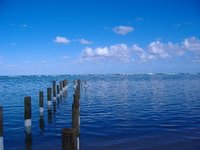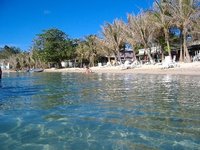Roatan
Travel Guide Islas de la Bahía Roatan
Introduction

Incomplete dock in Sandy Bay, Roatan
© GregW
Roatan is one of the most popular tourist destinations in the country. The biggest draw are the amazing reefs in crystal clear water making for great diving. In recent years some mega resorts have started to open up bringing in a higher class of tourist. Another fascinating thing to explore is the local Caracole population. Decedents of runaway slaves, freed slaves and Europeans looking for refuge in the 19th century this population is still alive and strong, even with the recent influx of immigrants from the mainland.
Towns
- Coxen Hole is the capital and largest town on the island. It is also the location of the airport.
Sights and Activities

Half Moon Bay beach, West End, Roatan
© GregW
- Diving in the reefs around the island is the main draw for most tourists.
- Beeches are always fun and these ones are especially nice.
Weather
Although Roatan is a great place to enjoy the beaches and watersports, the weather is not always that nice. October to February is rainy season, with a smaller rainy season in June and July. Temperatures are between 25 °C and 30 °C most of the year, but some nights can be cool with temperatures dropping to around 15 °C in January.
Getting There
By Plane
Juan Manuel Gálvez International Airport (IATA: RTB, ICAO:MHRO) is also known as the Roatan International Airport. This airport has regular service to La Ceiba, San Pedro Sula, Tegucigalpa, Belize City, San Salvador, Miami, Houston and Atlanta. There is also seasonal service to Toronto, Montreal, Ottawa and Newark. There are direct flights with Blue Panorama Airlines to/from Milan.
By Boat
There is regular ferry service to and from the mainland. Safeway Maritime’s new Galaxy Wave catamaran ferry provides fast, comfortable services between Roatán and La Ceiba (economy/first class US$21/26.50, 1¼ hours). There are daily departures from La Ceiba to Roatán at 9:30am and 4:30pm, and from Roatán to La Ceiba at 7:00am and 2:00pm.
Getting Around
By Car
Car rentals as well as motorcylces are available on Roatan, starting at around US$50 per day.
Renting scooters is a very economical and fun way to see the island. The asphalt road is reasonably well maintained and there is lots to see on Roatán besides the West End, so hire a scooter and start exploring. The rental agencies will happily provide you with detailed maps and explanations on how to best see the island. Scooter rentals are abundant in West End.
By Public Transport
Buses run every 15 minutes between Coxen Hole and West End during the day. They depart from opposite the market in Coxen Hole. Buses run every hour to Oak Ridge, stopping at the new ferry terminal and passing through French Harbor, Polly Tilly Bight, and Punta Gorda on the way. These buses leave from opposite the HB Warren supermarket in Coxen Hole.
Water taxis are used on the island to get to different spots. They are useful for getting between West End and West Bay.
On Roatan minibuses are available, costing around US$1-2 per ride.
Eat
The restaurants you will find along the West End beach are slightly more expensive than similar restaurants on the mainland, but the food is of a very high standard. Seafood abounds, and you can find a top quality lobster dinner for around US$10 US. Argentinian steaks are also popular.
There is a small food caravan located on the main road hosted by an ex-pat Aussie. The food is cheap, and he is open late, which is perfect for when you return home from one of the West Ends night spots.
Drink
Roatán boasts a wide array of experiences for night life, depending on your taste. Since the arrival of cruise ships, prices have risen somewhat, and restaurants and bars cater to cruise passengers as well as North American and European tourists. These types of establishments are relatively easy to find, as they are mostly located in and around the West End. Prices here are generally higher than in most other places on the island.
The best part about drinking in the west end is the pub crawl that occurs almost every night. Its virtually mandatory to start at Sundowners and enjoy drinks whilst watching the sun go down over the beautiful bay in front. When Sundowners shuts at 10PM the whole bar shifts about 50 m down the street to kick on at the Purple Turtle where you can enjoy live music out the back. The Purple Turtle closes at midnight and from here most people continue on to the Nova Bar, (or the Twisted Toucan's) which will be the joint to party at and where you will meet most of the locals in the region, this being a favorite haunt. Most people go home from here, but if you really are feeling like an adventure grab a group of friends and head down the beach to FuBar.
Sleep
There are excellent accommodations ranging from US$4-$400 per night. Condos are available as are beach cabanas.
Upscale
Keep Connected
Internet
No matter where you are in Honduras, you should find Internet access, either in a cafe, mall, or cybercafe. Most hotels, even hostels, have their own Internet service, and more and more are beginning to have Wi-Fi service. Roughly 90% of these hotels offer Wi-Fi for free, yet some international chain hotels in Tegucigalpa and San Pedro Sula, as well as a few resorts on Roatán, charge a fee that ranges between US$6 and US$15 per day. If the hotel does not have Internet service, the hotel staff can usually point out where to find it. Expect to pay approximately 20 lempira per hour.
Phone
See also International Telephone Calls
The emergency numbers are 199 (police), 195 (ambulance) and 198 (fire). The international area code in Honduras is 504. All local phone numbers are eight digits, including the area code. Numbers either start with a 2 (landline) or a 9 (cellular).
Kiosks and convenience stores throughout Honduras sell phone cards with individual instructions on long-distance dialing, and phone booths at telephone centers will provide instructions on dialing.
Honduras's largest phone companies, such as Telefonica, operate on a GSM 850 or 1900 MHZ frequency, which several large North American carriers also use, though these frequencies are rare in other parts of the world. Any dual or multiband GSM cellphone will work in Honduras, but you might pay expensive roaming rates; it's better to buy a local SIM card and install it in your own cell phone for cheaper rates.
You can also rent a phone at kiosks located on the arrival level at the San Pedro Sula or Tegucigalpa airport; they are open daily from 6:00am to 9:00pm. Depending on your service, you may be able to insert your own SIM card, though you'll likely still pay regular roaming rates. Some cellphone companies in Honduras will rent phones with prepaid calling cards.
Post
Honducor is the country's national postal service. Post offices are open from Monday to Friday from 8:00am to 5:00pm (though generally with a long lunch break) and on Saturday from 8:00am to noon. Sendings standard letters or postcards internationally start at around US$1 and take 10-14 days at least. You can get stamps at a post office and at some gift shops in large hotels. The Honduran postal service is renowned for being considerably more reliable than in other Central American nations, though if you are sending anything of value, it is still recommended to use an international courier service like DHL, UPS, TNT or FedEx, which have offices in larger cities.
External Links
Accommodation in Roatan
We have a comprehensive list of accommodation in Roatan searchable right here on Travellerspoint.
Contributors
 Utrecht (81%)
Utrecht (81%)
from https://utrecht.travellerspoint.com
Roatan Travel Helpers
We don't currently have any Travel Helpers for Roatan
This is version 22. Last edited at 3:22 on Aug 2, 17 by sleepBot. 15 articles link to this page.

Except where otherwise noted, content of this article is licensed under a Creative Commons Attribution-ShareAlike 3.0 License

